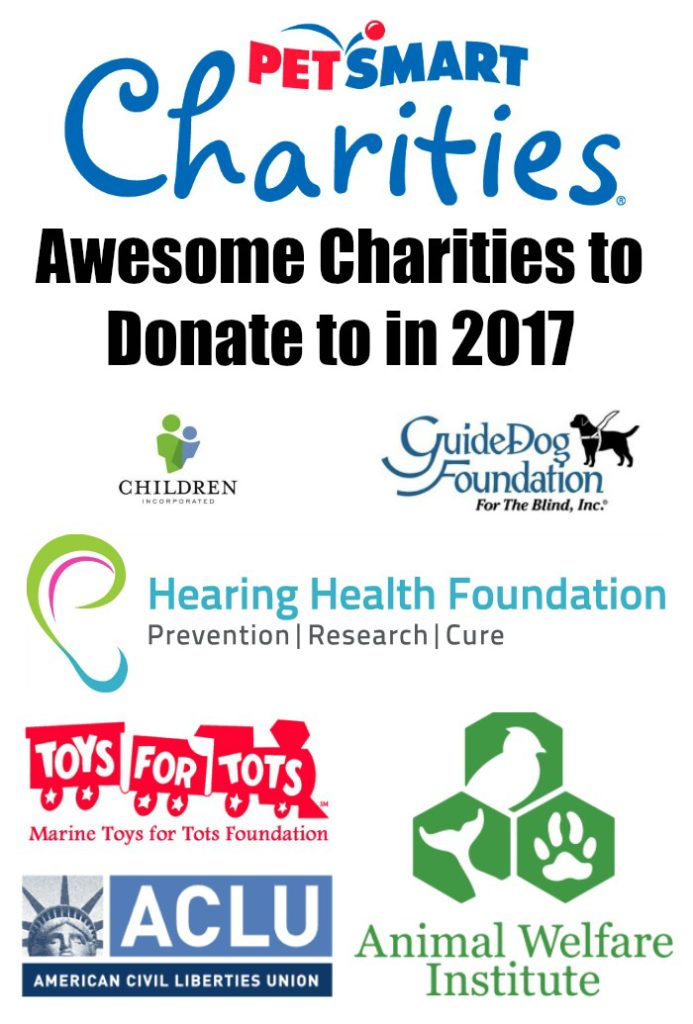
Women Give Back – Awesome Charities to Donate to in 2017

It’s easy to say that to want to help others, but it can be overwhelming, and confusing, to decide which charities are worthy of your donation.
Which charity deserves your hard-earned dollars?
Personally, I want to know which charities spend less money on overhead, and spend more on their actual programs.
You might want to know which charities align with your personal belief system? Do they discriminate against people of color, or the LBGTQ community?
Which charity works with a cause that is close to our heart? Saving animals, helping the homeless, providing aid after natural disasters or helping women and children?
Before making a donation, it’s a good idea to do some research on the charity you are considering donating to. The websites of charity watchdogs, (the biggest three: CharityWatch, Charity Navigator, and BBB Wise Giving Alliance) can be a huge help in determining where to send your dollars. Collectively, these watchdog groups evaluate thousands of nonprofit organizations based on how they collect and spend their money, how transparent they are to the public, and how well they’re governed.
Although each watchdog has its own system for assessing charities, they all use similar criteria. For example, CharityWatch says that for a group to have a satisfactory rating, at least 60 percent of its spending should go to the charity’s programs. To get the top rating, 75 percent of a group’s expenses must be used for its programs, and its fundraising costs cannot exceed 25 percent of the money it raises. Of course, funding the fund raising efforts equals more funds to distribute, but some charities do better than others.
Determine what is important to you as a donor and then do some research. But just in case you are super busy we did a little research for you. Here are three charities in some of the major giving categories that have ratings on all the watchdog sites linked above.
Charities by Category
Animal Welfare – Animal Welfare Institute, American Bird Conservancy, PetSmart Charities
Blind and Hearing Impaired – Guide Dog Foundation for the Blind, Hearing Health Foundation, National Federation of the Blind,
Cancer – Breast Cancer Research, Cancer Research Institute, Multiple Myeloma Research, Ovarian Cancer Research Fund
Child Assistance, Protection, and Sponsorship – Children Incorporated, Compassion International, Marine Toys for Tots Foundation
Human and Civil Rights – American Civil Liberties Union Foundation, Center for Community Change, Fund for Global Human Rights
Environment – Conservation Fund, Earthjustice, Earthworks,
Health – American Kidney Fund, Hearing Health Foundation, Guttmacher Institute,
Mental Health and Disabilities – Alzheimer’s Foundation of America, American Foundation for Suicide Prevention, Arc of the United States,
Veterans – Homes for Our Troops, Hope for the Warriors, The Mission Continues,
NOTE: Not one of the bigger charities for Police and Firefighters received a top rating. In fact, some of the larger of these charities made the WORST charity list. Donor beware! If supporting police and firefighters is a top priority for you consider donating locally. When the firefighters have a “Fill the boot campaign” or the local police have a “Fill the cruiser” campaign.
If you don’t see a charity listed it means 1) it wasn’t listed on ALL THREE watchdog sites, or 2) we missed something.
Keep in mind that just because a charity is LARGE does not mean it is one you will want to donate to. United Way Worldwide is only rated on two of the above watch dog sites. It’s a tricky charity to rate because you are actually giving money to an umbrella organization consisting of nearly 1,800 local United Way agencies in over 40 countries all over the world. Most of your donation stays in your local community, supporting charities you designate, while a portion is used for administrative expenses and fundraising. Since each local United Way has its own unique expenses, you have to look to your local organization to determine just where your donation goes.
Make sure you research any discriminatory giving practices by a charity. For example, the Salvation Army is openly homophobic, posts anti-gay messages on their website, and gives money to lobbying efforts focused on undermining the LGBT community. In fact, this organization is so homophobic that in 2004 they threatened to close NYC soup kitchens that were serving same-sexed couples. Supporting a charity means supporting their entire message, so be sure that the charity you choose aligns with your values.
Take a look at KIVA. They loan money to small business women around the world, and have a great rating on one of the watchdog sites, but isn’t listed on the other two. Word of mouth sets this one apart, as people seem to love that they can loan money directly to a woman in another part of the world (you even get to decide WHO to loan to) and you will get emailled updates as the loan is re-paid. Once it is paid, you can get your money back or loan it out again.
Consider supporting your local food bank. Feeding people in your own county or city is a good goal.
Hopefully, if this article doesn’t help you narrow down WHO to donate your money to, it will help you decide what is important to you. Most importantly, though, we hope it helps you to see that research, research, and more research are the best way to feel good about your charitable contributions and to make sure your donations are treated wisely.
Do you donate money to charities? How do you determine which charities to donate to?


















